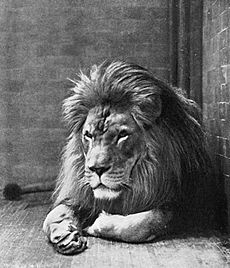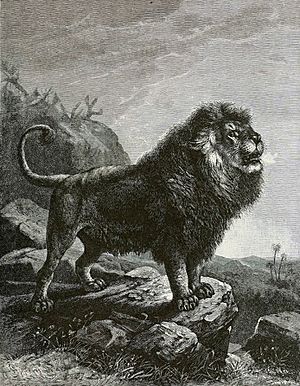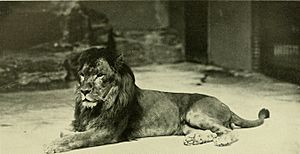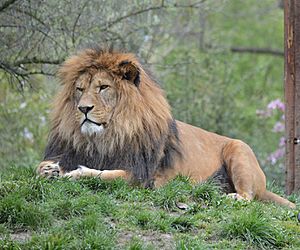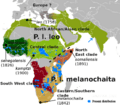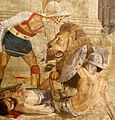Barbary lion facts for kids
Quick facts for kids Barbary lion |
|
|---|---|
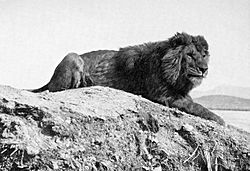 |
|
| A Barbary lion from Algeria, 1893 | |
| Conservation status | |
| Scientific classification | |
| Kingdom: | |
| Class: | |
| Order: | |
| Family: | |
| Genus: | |
| Species: | |
| Trinomial name | |
| Panthera leo leo (Linnaeus, 1758)
|
|
The Barbary lion was a special type of African lion. It lived in North Africa, especially in the Atlas Mountains. Because of this, it was also known as the Atlas lion. Sadly, this lion population is now extinct in the wild in North Africa.
People started hunting Barbary lions more often in the mid-1800s. This was because firearms became common, and people were paid for shooting them. The last known wild Barbary lion was shot in Morocco in 1942. Some small groups might have survived in Algeria until the early 1960s, and in Morocco until the mid-1960s.
Contents
What Made Them Special?
Barbary lions were known for their amazing manes. These manes were very thick and long. They even had hair on their sides and belly. This was different from most other lions. Only the Mesopotamian lion also had hair on its belly. Lions in Egypt often had no manes at all.
For a long time, people thought the color and size of a lion's mane showed if it was a different type of lion. But scientists later learned that many things affect a lion's mane. These include the temperature, how much food they get, and their testosterone levels. Lions from Sub-Saharan Africa kept in cool zoos often grow bigger manes. Barbary lions might have had long manes because the Atlas Mountains were much colder, especially in winter.
So, the mane size alone does not prove they were a unique type of lion. However, DNA studies in 2006 showed something interesting. They found a special genetic marker in museum specimens believed to be Barbary lions. This marker helps identify true Barbary lions that are still alive in zoos today.
The Barbary lion was once thought to be one of the biggest lion types. Some male Barbary lions in museums had very dark, long manes. These manes reached over their shoulders and down to their bellies. Stuffed male lions were about 2.35 to 2.8 meters (7.7 to 9.2 feet) long. Females were around 2.5 meters (8.2 feet) long. One hunter in the 1800s claimed to have seen a very large male. It was said to be 3.25 meters (10.7 feet) long, including its tail. Some old stories also said wild males weighed 270 to 300 kilograms (595 to 661 pounds). But these old measurements might not be fully accurate. Also, there were not enough captive Barbary lions to say for sure they were the biggest. Still, some people believed they were "much better" than other lions in size and bravery.
How They Lived
In areas where there were not many lions, Barbary lions often lived in pairs or small family groups. These groups usually had a male, a female, and one or two cubs. Sometimes, two older males and a female would live and hunt together. Records from 1839 to 1942 show that Barbary lions lived alone, in pairs, or in family groups. Even when they were hunted more, they still lived in prides. These prides were probably similar in size to those in other parts of Africa. However, there were likely fewer Barbary lions in the Atlas Mountains.
When their usual prey, like Barbary stags and gazelles, became hard to find, Barbary lions would hunt farm animals. They also hunted wild boar and red deer. Other large predators that lived in the same areas included the African leopard and the brown bear.
Why They Disappeared from the Wild
The Romans used Barbary lions in the Colosseum. There, they fought against gladiators.
Barbary lions lived across the Atlas Mountains in North Africa. By 1834, they might have already disappeared from the coastlines. This was where human settlements were. In Algeria, they lived in the forests and mountains. They were also found in the forests of the Constantine Province, stretching into Tunisia. By the mid-1800s, their numbers had dropped a lot. The last lions in Tunisia were gone by 1890.
In the 1970s, people thought Barbary lions had disappeared from the wild in the early 1900s. But later research found that a lion was shot in Morocco in 1942. Lions were also seen in Morocco and Algeria into the 1950s. Small groups might have survived in remote areas until the early 1960s.
Saving the Barbary Lion
In Zoos and Sanctuaries
In the past, Barbary lions were sometimes given as gifts to royal families. The rulers of Morocco kept these "royal lions" for many years. When the royal family went into exile, the lions were split among different zoos. In the late 1960s, a disease almost wiped out these royal lions. So, the current ruler built special homes for them near Rabat, Morocco. This helped improve their lives. Today, a small number of these "royal lions" are believed to be pure Barbary descendants. They have the right family history and look like the original Barbary lions.
In the 1800s and early 1900s, Barbary lions were often kept in hotels and circus animal shows. A famous Barbary lion named "Sultan" lived at the London Zoo in 1896.
Emperor Haile Selassie I of Ethiopia also had a collection of lions. They looked like Barbary lions because of their dark, long manes.
Today, many researchers and zoos are working to keep track of lions that came from the King of Morocco's collection. They believe these lions might have unique Barbary lion genes. They also show what the original Barbary lions looked like.
As of 2016, some zoos in the United States claim to have Barbary lions. For example, Wisconsin Big Cat Rescue has two female lions that DNA tests show are Atlas lions. Other parks also say they have Barbary lions.
Cultural Importance
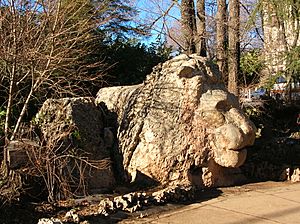
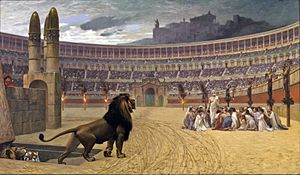
Barbary lions from North Africa were used in Roman gladiatorial games.
Omar Mukhtar, a revolutionary from Libya, was called the "Lion of the Desert." This shows how important the lion was as a symbol of bravery.
Images for kids
-
The last photograph of a wild lion in the Atlas Mountains, taken by Marcelin Flandrin on a flight from Casablanca to Dakar in 1925
-
Painting of a lion hunt in Morocco by Eugène Delacroix, 1855, in the Hermitage Museum
See also
 In Spanish: León del Atlas para niños
In Spanish: León del Atlas para niños



